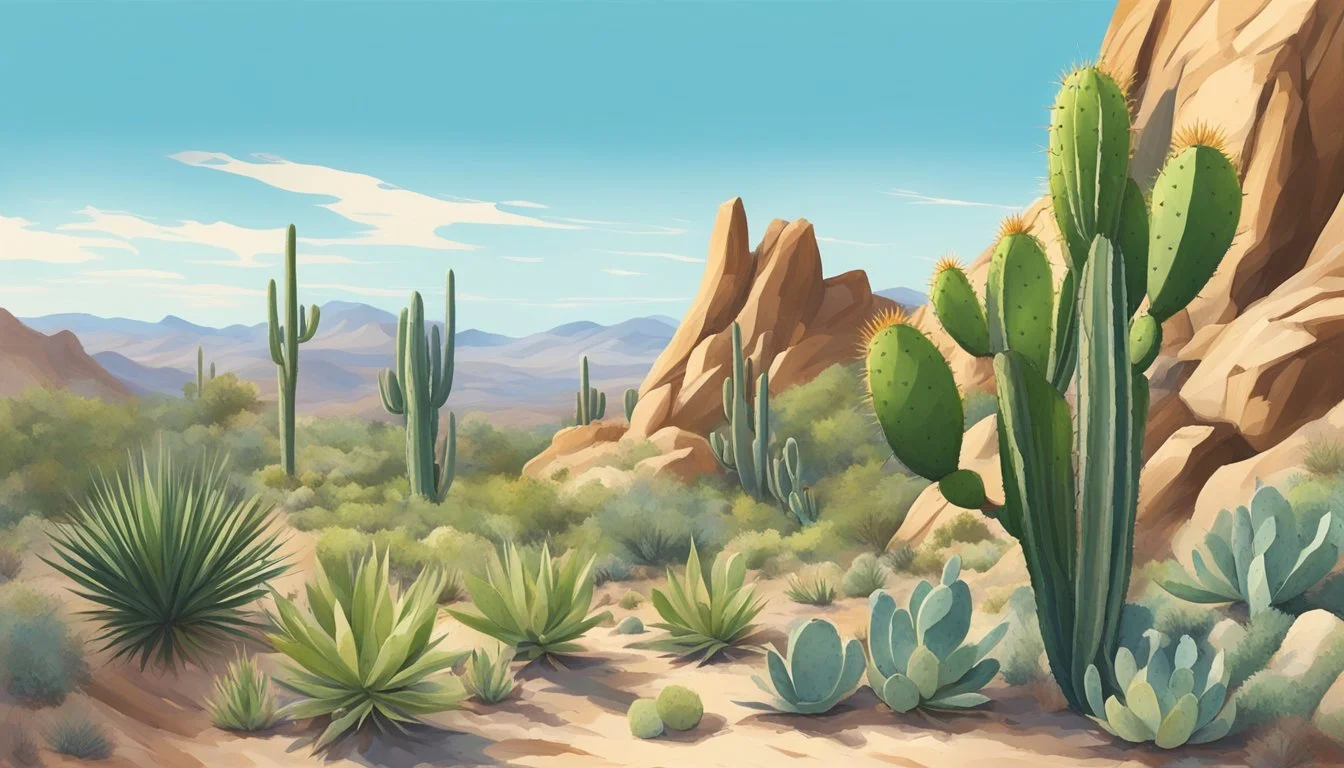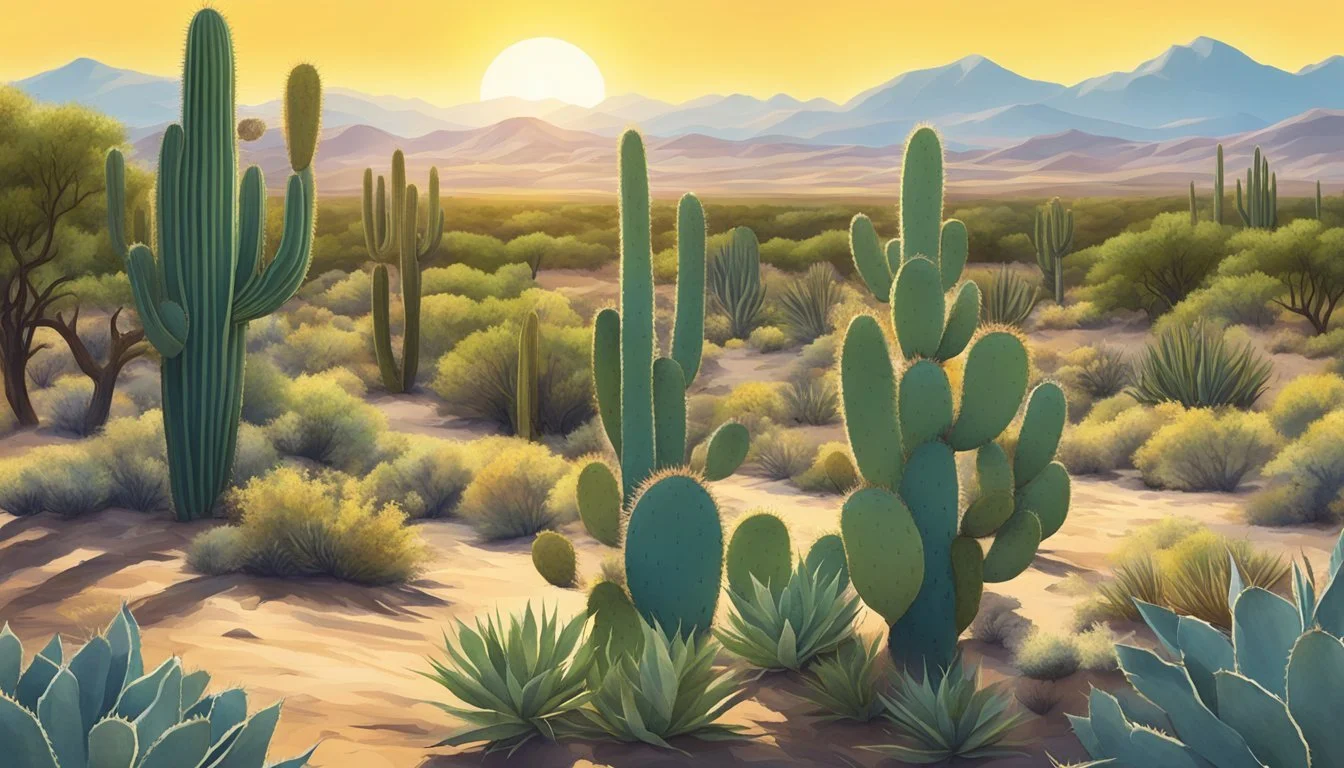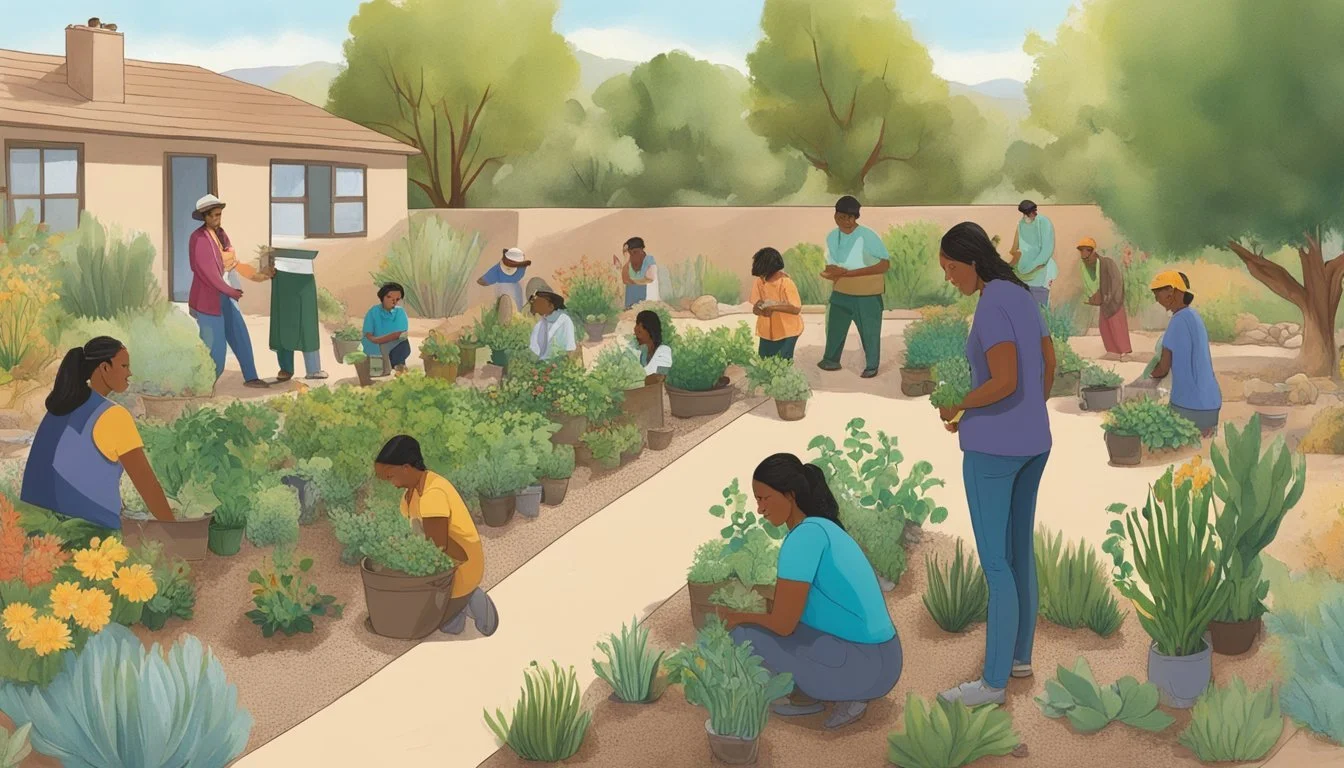Southwest Native Edible Plants
A Guide to Indigenous Foods
In the arid landscapes of the Southwest, a myriad of native plants have adapted to survive and thrive in harsh conditions. These resilient species offer not only ecological benefits but also culinary delights. From the iconic saguaro fruit to nutrient-rich agave, these plants have been integral to indigenous cultures for centuries. Their ability to provide sustenance in a challenging environment is nothing short of remarkable.
Edible plants in the Southwest region, such as prickly pear cactus and mesquite, are known for their unique flavors and nutritional benefits. Prickly pear cactus can be eaten raw or cooked, offering a sweet and mildly tangy flavor, while mesquite pods are often ground into flour for baking. These plants not only highlight the ingenuity of native peoples but also offer modern foragers a taste of the region's rich agricultural history.
Exploring the native edible plants of the Southwest opens a door to a world of diverse and flavorful options. Creosote bush, for instance, provides resin that can be used for medicinal purposes, while the versatile yucca plant offers both edible flowers and roots. Understanding the uses and benefits of these plants can enrich our culinary experiences and deepen our connection to the natural world.
Historical Use of Edible Plants in the Southwest
Historically, the Southwest has been a region rich in diverse edible plants utilized by Native Americans and later influenced by Spanish colonization. The following sections explore these cultural interactions and their impacts on traditional diets.
Native Americans and Traditional Diets
Native Americans in the Southwest relied heavily on foraging as part of their subsistence strategy. They gathered plants like agave, which had multiple uses such as food, fiber, and traditional alcoholic beverages. The sweet nectar of the agave could be fermented into pulque, a staple in many ceremonies.
Barrel cactus fruits, notable for being needle-free, were commonly consumed raw. They provided a reliable source of hydration in arid climates. The seeds were also edible and often integrated into the diet. Pine nuts were another important food, gathered in large quantities during harvest season.
Pinyon pines, yucca, wild onions, and various berries were regularly collected. Each plant had specific methods for preparation and preservation. Knowledge of these practices was passed down through generations, ensuring the survival of both the people and the plants.
The Spanish Influence on Indigenous Foods
Spanish colonization brought significant changes to the Indigenous diets of the Southwest. With the arrival of the Spanish, new crops such as wheat, grapes, and various citrus fruits were introduced. These additions complemented traditional foods and broadened the overall diet.
The Spanish also brought livestock, leading to the integration of meat, dairy products, and poultry into the native cuisines. This diversification altered traditional food systems but also enriched them by providing new nutritional sources.
The adoption of Spanish agricultural techniques, such as irrigation methods, further transformed the landscape and food production capabilities in the region. Native methods of foraging and farming were complemented by these techniques, creating a hybrid system of food cultivation and consumption.
Native Plant Identification and Habitat
Identifying native plants in the Southwest involves understanding their unique adaptations to arid environments and using reliable resources. The Sonoran Desert and similar habitats are home to a diversity of species that have evolved to thrive in harsh conditions.
Desert Environments and Plant Adaptations
Southwestern native plants have developed remarkable adaptations to survive in desert climates. For instance, the Barrel Cactus has a thick, round shape that helps conserve water. Its flowers and fruits are not only edible but can also be consumed raw. The Prickly Pear Cactus features fleshy pads that store water, and its fruit is both edible and nutritious, often used in local cuisine.
Other notable plants include the Desert Marigold and various species of Agave, which have deep root systems to access underground water. In the Sonoran Desert, these adaptations are essential for survival, making these plants integral to the ecosystem. Understanding these adaptations is crucial for proper identification and appreciation of their roles in their native habitats.
Field Guides and Plant Identification Resources
Accurate identification of Southwest native plants is greatly aided by comprehensive field guides. Books like Common Southwestern Native Plants, An Identification Guide offer detailed visuals and descriptions, making them indispensable for enthusiasts and researchers. The second edition of this guide, published in 2009, is renowned for its user-friendly format.
Online resources like "Edible Plants of Colorado" and "Plants Of The Southwest" also provide valuable information on plant habitats, edible parts, and medicinal uses. These guides often include photographs of plants in various growth stages, which is beneficial for precise identification. Resources focusing on the Sonoran Desert are particularly useful given the unique flora of this region.
Medicinal Uses of Native Flora
Many native plants of the Southwest hold significant medicinal value. From treating respiratory issues to aiding digestion, these plants have been traditionally used for various health benefits.
Healing Properties of Southwestern Plants
Yerba Santa is known for its support of respiratory health. It helps with conditions like coughs, colds, and asthma.
Desert Marigold is used for its anti-inflammatory properties. It can ease skin irritations and promote wound healing.
Prickly Pear Cactus is beneficial for its high antioxidant content. It supports the immune system and aids in digestion.
Agave has antibacterial properties. Its sap can treat skin infections and accelerate wound healing.
Juniper is known for its anti-inflammatory and antiseptic qualities. It can help with urinary tract infections and skin conditions.
Medicinal Plants and Modern Applications
Yerba Santa continues to be used in herbal teas and tinctures, especially for respiratory ailments. It remains a popular ingredient in natural remedies for colds and coughs.
Agave is now widely used in skincare products for its soothing and antimicrobial properties. It also finds use in natural sweeteners due to its high sugar content.
Juniper is used in modern herbal medicine for its detoxifying effects. Its berries are often included in supplements aimed at kidney and urinary health.
Prickly Pear Cactus is being studied for its potential to lower blood sugar levels. It is also used in juices and dietary supplements for its nutritional benefits.
Desert Marigold extracts appear in natural skincare and anti-inflammatory treatments, continuing its traditional use in modern practices.
Cultivating and Growing Edible Native Plants
Cultivating edible native plants in the Southwest involves understanding unique soil requirements and climate considerations. By following specific tips, one can successfully incorporate these resilient plants into home gardens to create sustainable, productive landscapes.
Tips for Successful Growth in Arid Climates
Selecting Appropriate Species: Choose native plants such as the Prickly Pear Cactus, Desert Marigold, and Barrel Cactus, which are well-adapted to the arid climate of the Southwest.
Soil and Water Management: Native edible plants often require well-draining soil and minimal watering. For instance, American cranberry plants need consistently moist, acidic soil with a pH between 4.0 and 5.2. Integrating a drip irrigation system helps maintain soil moisture without overwatering.
Sunlight and Temperature: Most native plants thrive in full sun. The plants, such as Agave, typically withstand high temperatures and can flourish with proper sunlight exposure.
Protecting from Pests: Implementing organic pest management strategies, like using neem oil or companion planting, can protect these plants from local pests without harming the environment.
Incorporating Native Edibles into Home Gardens
Design and Placement: Integrate native plants into your home gardens and landscapes by using them as focal points or borders. For example, Prickly Pear Cactus and Agave can create striking visual interest.
Companion Planting: Pair native edibles with other drought-tolerant plants to maximize space and resources. Plants like Pueblo Corn can be interspersed with herbs that share similar watering needs.
Harvest and Usage: Knowing when and how to harvest is crucial. For instance, Barrel Cactus fruits are edible when ripe and can be picked easily. Educate yourself on the specific harvest times to make the most of your garden.
Ecological Benefits: Incorporating native edible plants can enhance biodiversity, support pollinators, and contribute to a more resilient ecological system, making your garden a haven for local wildlife.
Harvesting and Consuming
Understanding how to harvest and consume native edible plants of the Southwest is essential. This involves knowing the best times to gather these plants and the proper practices to ensure sustainability and safety.
Seasonal Harvesting Guide
In the spring, plants like dandelion leaves and mesquite pods can be gathered. Dandelion leaves should be picked when they are young and tender. Mesquite pods are collected for their sweet, edible pulp.
During summer, the prickly pear cactus bears fruit. The fruit can be picked and eaten raw after removing the spines. Barrel cactus fruit is another summer treat, easily harvested due to its lack of needles.
Spring Harvested Plants:
Dandelion Leaves: Young, tender leaves are ideal.
Mesquite Pods: Contains sweet pulp.
Summer Harvested Plants:
Prickly Pear Fruit: Requires careful handling to remove spines.
Barrel Cactus Fruit: Safe to pick and eat raw.
Safe Foraging Practices and Ethics
When foraging, it is crucial to identify plants correctly to avoid harmful species. Use reliable guidebooks or mobile apps designed for plant identification. Only take what is needed, leaving enough for wildlife and future growth.
Respect private property and local regulations regarding foraging. Some areas may have restrictions to protect endangered species or fragile ecosystems. Always forage responsibly to ensure the sustainability of these native plants.
Foraging Tips:
Bring identification tools such as guidebooks.
Harvest in moderation to maintain plant populations.
Follow local rules and guidelines regarding foraging.
Respect nature by leaving no trace and not disturbing habitats.
By following these guidelines, foragers can enjoy the rich bounty of the Southwest's edible plants while contributing to their preservation.
Edible Plant Profiles
The Southwest United States is home to various native edible plants that are not only nutritious but also deeply rooted in the region's culture and history. This section highlights the Prickly Pear Cactus, the multi-functional Mesquite Trees, and the highly nutritious Nopales.
Prickly Pear Cactus: A Versatile Delicacy
The Prickly Pear Cactus (Opuntia spp.) stands out for both its culinary and medicinal uses. Its fleshy pads, known as nopales, can be harvested and prepared in numerous ways. Nopales are a common ingredient in salads, stews, and grilled dishes.
The fruit, or "tuna," of the Prickly Pear Cactus is also edible. It has a sweet, tangy flavor and can be eaten raw, made into jams, or used in drinks. Consuming the fruit can provide a good source of vitamin C and fiber. Handle with care due to the spines.
Mesquite Trees: More Than Just Wood
Mesquite Trees (Prosopis spp.) offer more than durable wood; their pods are a valuable food resource. The sweet, yellow pods can be ground into mesquite flour, a traditional ingredient in breads and pastries.
Mesquite beans are also edible and can be consumed whole or processed into syrup. These beans are rich in protein and beneficial to those seeking plant-based nutrients. Mesquite has historical significance in indigenous food practices as well.
The Nutritious Nopales
Nopales, the pads of the Prickly Pear Cactus, are a staple in Southwest cuisine. These pads are harvested when young and tender and must be meticulously cleaned to remove spines.
Nopales are high in fiber, vitamins A and C, and antioxidants. Common preparations include grilling, boiling, or sautéing them. They can be incorporated into dishes such as tacos, salads, and egg scrambles, providing both flavor and nutritional benefits.
Integrating Edibles into the Broader Ecosystem
Integrating native edible plants into the broader ecosystem offers multiple benefits, such as promoting biodiversity and conserving wildlife. These plants not only enrich local habitats but also support a variety of species that rely on them for survival.
Promoting Biodiversity with Native Edibles
Native edible plants enhance biodiversity by providing food and shelter to a wide range of organisms. For instance, species like the Desert Marigold and Prickly Pear Cactus offer nectar and pollen for pollinators such as bees and butterflies.
Additionally, native edibles contribute to soil health. Agave and Pueblo Corn, by virtue of their natural adaptations, improve soil structure and promote a balanced ecosystem. These plants also foster beneficial microbial activity, which is crucial for nutrient cycling in the soil.
Integrating these plants can help maintain ecological balance and offer resilience against invasive species. For example, communities can prevent the spread of non-native plants by encouraging the growth of local edibles suited to their landscapes.
Native Edibles and Wildlife Conservation
Native edible plants play a vital role in wildlife conservation. Species such as the Desert Marigold not only aid pollinators but also support herbivores that depend on them for nourishment.
Many animals rely on these plants during critical periods. The Prickly Pear Cactus, for example, provides fruit that sustains various bird species through dry summer months. These interactions underscore the importance of preserving native plants for the survival of local fauna.
Moreover, the integration of native edibles into gardens and conservation areas helps create habitats that mimic natural ecosystems. This approach supports a diverse range of wildlife and encourages the presence of species adapted to local conditions, fostering a robust and healthy environment.
Educational Resources and Community Engagement
Educational resources and community engagement are pivotal in promoting the conservation and use of native edible plants in the Southwest. Classes, workshops, and community initiatives enhance awareness and participation.
Workshops and Classes on Native Edibles
Various organizations offer workshops and classes that educate individuals about native edible plants. These sessions often cover plant identification, sustainable harvesting techniques, and culinary uses. The Nevada Native Plant Society frequently hosts events that delve into the various native species found in the region.
Participants benefit from hands-on experience, guided by experts with extensive knowledge of local flora. Workshops conducted by community gardens often incorporate practical gardening tips, ensuring attendees can grow and maintain their own native plants.
Classes might also feature guest speakers who are botanists or foraging experts, underlining the medicinal and nutritional value of these plants. By attending these educational opportunities, community members develop a deeper understanding and appreciation for native species, contributing to their preservation and use.
Building Community Around Native Food Sources
Community gardens play an essential role in fostering a sense of community around native food sources. These gardens not only provide a space for individuals to grow native plants but also act as hubs for educational and social events. Members of the community can collaborate, sharing knowledge and resources.
Local programs often encourage community engagement through volunteer opportunities, workshops, and seasonal events. For example, the Plants of the Southwest initiative promotes the cultivation of culturally significant plants like Agave and Pueblo Corn, bringing people together over shared heritage.
These spaces often serve as platforms for discussing the ecological and cultural importance of native plants. By integrating educational activities and community-building efforts, these initiatives help ensure the ongoing interest and participation in sustainable practices surrounding native edibles.







